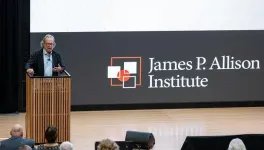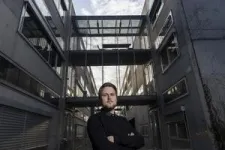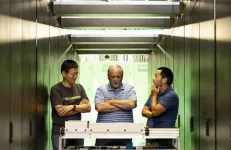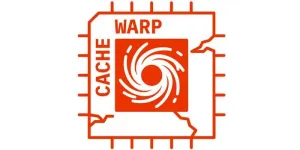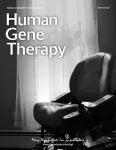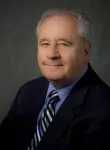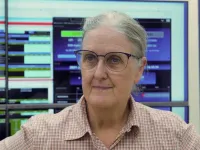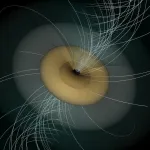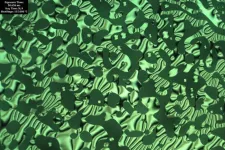(Press-News.org) HOUSTON ― The James P. Allison Institute at The University of Texas MD Anderson Cancer Center hosted its inaugural scientific symposium on Nov. 10 at the TMC3 Collaborative Building in the Texas Medical Center’s Helix Park. The event brought together more than 400 leading scientists, including three Nobel laureates, from multiple disciplines to share groundbreaking immunotherapy and immunobiology research.
“Our inaugural symposium is an important milestone representing significant progress for the Allison Institute since we launched last year, and we’re energized by the exceptional science shared by our members and colleagues,” said Nobel laureate James P. Allison, Ph.D., director of the Allison Institute and regental professor and chair of Immunology at MD Anderson. “With an incredible environment and amazing collaborators, I look forward to our continued work to advance immunotherapy cures.”
The Allison Institute was created to advance exceptional discovery, translational and clinical research that will integrate immunobiology across all disciplines. By gaining a comprehensive understanding of the immune system, the institute aims to lead groundbreaking research that will bring the benefits of immunotherapy to all patients.
The symposium opened with remarks from MD Anderson President Peter WT Pisters, M.D., and Allison, followed by presentations from 13 leading clinicians and scientists focused on themes from the Allison Institute’s priority research areas. Featured speakers included:
Robert Schreiber, Ph.D.
Andrew M. and Jane M. Bursky Distinguished Professor of Pathology and Immunology
Director, Bursky Center for Human Immunology and Immunotherapy Programs
Washington University School of Medicine
Allison Institute Scientific Advisory Board Co-Chair
Elaine Mardis, Ph.D.
Co-Executive Director, Steve and Cindy Rasmussen Institute for Genomic Medicine, Nationwide Children’s Hospital
Rasmussen Nationwide Foundation Endowed Chair of Genomic Medicine
Professor of Pediatrics, The Ohio State University College of Medicine
Allison Institute Scientific Advisory Board Co-Chair
Carolyn Bertozzi, Ph.D.
Nobel Prize in Chemistry 2022
Baker Family Director of Stanford ChEM-H
Anne T. and Robert M. Bass Professor of Humanities and Sciences
Professor of Chemical and Systems Biology, Professor of Radiology
Stanford University
Phillip Sharp, Ph.D.
Nobel Prize in Physiology or Medicine 1993
Emeritus Professor
Member, Koch Institute for Integrative Cancer Research
Massachusetts Institute of Technology
Tak Mak, Ph.D.
Senior Scientist
Princess Margaret Cancer Centre
Director, The Campbell Family Institute for Breast Cancer Research
Professor of Medical Biophysics
University of Toronto
Padmanee Sharma, M.D., Ph.D.
Director of Scientific Programs, Allison Institute
Associate Vice President of Immunobiology
Professor of Genitourinary Medical Oncology and Immunology
MD Anderson
“The Allison Institute is aligned with MD Anderson’s mission to end cancer, and we are committed to building on the great promise of immunotherapy to improve treatments for millions of patients,” Pisters said. “I am certain this inaugural symposium will drive further impact for the Allison Institute. With insights from distinguished scientists from around the world, we are fostering collaboration, inspiration and new ideas that can move immunotherapy forward in unbelievable ways.”
- 30 -
END
The team that built Frontier set out to break the exascale barrier, but the supercomputer’s record-breaking didn’t stop there.
“The exascale number marks a major milestone itself, but it also marks the beginning of a new chapter in high-speed computing,” said Feiyi Wang, an Oak Ridge National Laboratory computer scientist who leads research into artificial intelligence and analytics. “We don’t have to wait for the next generation of computing anymore. We can have it here today.”
Frontier claimed the title of fastest computer in the world by running at ...
COLUMBUS, Ohio – For the first time, teachers in a nationwide study have told researchers what strategies they think work best to deal with student violence against educators.
Teachers rated suspending or expelling students as the least effective way of addressing violence, despite the popularity of “zero tolerance” policies in many school districts.
Instead, teachers rated prevention policies, such as counseling for troubled students and improving school climate, as the best strategy for dealing with violence.
“Teachers ...
In the area of cloud computing, i.e. on-demand access to IT resources via the internet, so-called trusted execution environments (TEEs) play a major role. They are designed to ensure that the data on the virtual work environments (virtual machines) is secure and cannot be manipulated or stolen. Researchers at the CISPA Helmholtz Centre for Information Security and Graz University of Technology (TU Graz) have now discovered a security vulnerability in AMD processors that allows attackers to penetrate virtual work environments based on the trusted computing technologies AMD SEV-ES and AMD SEV-SNP. This is achieved by resetting data changes in the buffer memory (cache), which gives ...
Philadelphia, November 14, 2023 – Cooking and recipe demonstrations encourage healthy eating and adoption of unfamiliar foods by class participants. The research brief shared in the Journal of Nutrition Education and Behavior, published by Elsevier, demonstrates that valuable input by peer educators can be obtained through a hybrid home-use testing method.
The process of recipe development involves sensory evaluation about the appearance, aroma, taste, texture, and flavor of the food. Although a controlled laboratory setting is the gold standard for evaluation because of consistent preparation and presentation of food, bringing peer educators to a ...
New Rochelle, NY, November 13, 2023—A new review article in the peer-reviewed journal Human Gene Therapy summarizes the significant milestones in the development of gene therapy medicinal products that have facilitated the treatment of a significant number of rare diseases. The article also describes the challenges in the progress of gene therapy for rare diseases. Click here to read the article now.
Juan Bueren, from Centro de Investigaciones Energéticas Medioambientalies y Tecnológicas (CIEMAT), ...
HIV pre-exposure prophylaxis (PrEP), a daily dose of two medications meant to prevent HIV infection in high-risk people, has changed public health dramatically in recent years. Yet, adolescents and young adults, one high-risk group, have shown slower uptake in using this prevention method.
Despite accounting for around 20 percent of new HIV infections, adolescents and young adults between the ages of 13 and 24 are still largely not being prescribed PrEP. Research has described physician intentions to prescribe PrEP to at-risk young people, but no studies until now have focused on factors that may affect actual prescribing of this evidence-based ...
The American Society of Civil Engineers (ASCE) recently instituted the Dan M. Frangopol Medal for Life-Cycle Engineering of Civil Structures in recognition of the Lehigh Engineering professor’s contributions as a pioneering researcher and educator and leading authority in the fields of life-cycle civil engineering and life-cycle cost optimization.
The award pays tribute to Frangopol, the inaugural Fazlur R. Khan Endowed Chair of Structural Engineering and Architecture in the Department of Civil and Environmental Engineering ...
Dr. Marcia Rieke, principal investigator for the Near-Infrared Camera on NASA’s James Webb Space Telescope is the Astronomical Society of the Pacific’s (ASP) 2023 recipient of its most prestigious award. ASP’s Catherine Wolfe Bruce Gold Medal honors Rieke, a Regents Professor of astronomy and Elizabeth Roemer Endowed Chair, Steward Observatory, at the University of Arizona. Rieke’s award and achievements was recognized at the ASP Awards Gala on Saturday, Nov. 11, in Redwood City, California.
Groundbreaking Contributions
Rieke’s research has focused on infrared observations of ...
The one thing everyone knows about black holes is that absolutely everything nearby gets sucked into them.
Almost everything, it turns out.
“Even though black holes are defined as objects from which nothing can escape, one of the astonishing predictions of Einstein’s theory of relativity is that black holes can actually lose energy,” says astrophysicist Eliot Quataert, Princeton’s Charles A. Young Professor of Astronomy on the Class of 1897 Foundation. “They ...
CHAMPAIGN, Ill. — A new study led by chemists at the University of Illinois Urbana-Champaign brings fresh insight into the development of semiconductor materials that can do things their traditional silicon counterparts cannot – harness the power of chirality, a non-superimposable mirror image.
Chirality is one of nature’s strategies used to build complexity into structures, with the DNA double helix perhaps being the most recognized example – two molecule chains connected by a molecular “backbone” ...
